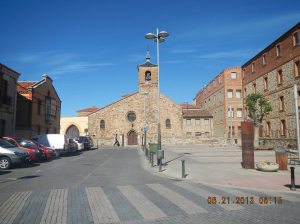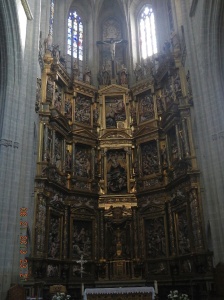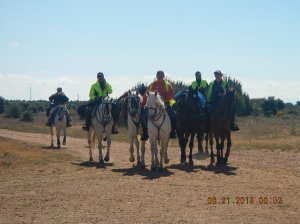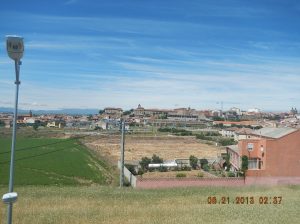
Dena and Ian leading us in to Astorga. The Roman name for the town, Asturica Augusta, is in the middle of the traffic circle.
CLICK ON THE PICTURES TO ENLARGE TO FULL-SIZE
As you walk through (and up to) Astorga you get a tour of the history of the town. The Roman name for the town, Asturica Augusta, gives us the name of the of the bygone Astur tribe whose capital this town once was. The intersection here reminds us also that Astorga was and is located at the crossroads of the east-west Via Traiana and the north-south Via de la Plata that begins in Andalucía. This crossroads and indeed the town itself was important to the Romans because it guarded the mountain roads to the profitable mines. For peregrinos traversing both of these pilgrim routes it is no less important because it gives them an opportunity to rest and gather up their strength before climbing the imposing mountains that guard the way to El Bierzo and Galicia.
After tackling a steep incline to you are in the Plaza San Francisco and from here history tells us that Astorga was an important Christian Center. So important was it that at the height of the pilgrimage it hosted no less than 21 hospices – this impressive number of hospices was only second to Burgos. St. Francis of Assisi was a peregrino that stayed here on his way to Santiago de Compostela in 1214.

The view from the Jardin de La Sinagoga, a park that shows the city walls that were originally Roman but have been reconstructed many, many times.
The city walls seen from the Jardin de La Sinagoga remind us that Astorga was called by Pliny an urbs magnifica and being one was also heavily fortified. As you look at the walls you can picture the relentless attacks (now happily a thing of the past) that this stronghold endured be it from a Germanic tribe called the Suevi, Muslim invaders in 714, or the French during the Napoleonic Wars of the 19th century. It was this last group of invaders that destroyed much of the remaining Roman wall.
The Jardin de La Sinagoga (it translates to the Garden of the Synagogue) also reminds us that Astorga was once home to a thriving Jewish community. Here in 1073 a synagogue was founded to be followed by a Jewish cemetery in 1092. The number of Jewish inhabitants was such that it supported two separate Jewish neighborhoods. Why so many? It was simply because and almost unique to Astorga that Jews were welcomed and participated in all aspects of city life until their expulsion from Spain in 1492.
A slight climb up from the Plaza San Francisco is the Plaza San Bartolomè. For us this was where we had our famous Maragato stew in the Restaurante Casa Maragato II. This plaza is noteworthy for the Roman Museum located in a Roman construction called the Ergástula that before its present-day use was utilized as an access tunnel, slave enclave and a jail.
Link to the Roman Museum in Astorga
The Plaza Mayor is a very, very short walk and it was here that I enjoyed an espresso while taking in the magnificent Ayuntamiento with its beautiful 17th century Baroque facade (1683-1704). The clock of the Ayuntamiento features mechanical figures of a man and woman dressed in traditional Maragato costumes striking the bell every hour. Close to here you can also find remains of Roman baths, sewers and walls.
Next on this walking tour and north of the Plaza Mayor is the Plaza Santocildes and here Astorga’s Napoleonic past is celebrated with a majestic lion statute that reminds us of the siege of Astorga which began on March 21, 1810 when Napoleon’s 8th corps, consisting of 12,000 men, including 1,200 cavalry surrounded the city. The town was defended by Marshal José María Francisco Silvestre Santocildes y de Llanos and 2,700 Spanish Infantry. The siege was a stalemate until April 15 when 18 siege guns were delivered to the French. By the 20th, the wall of the city was breached with the French storming the city the next evening. This first attack was repulsed at the cost of 300 men. The next morning, Santocildes surrendered as the French were preparing for another attack because he had almost run out of ammunition with fewer than 30 rounds left per man and only 8 rounds of artillery. French losses were 160 men killed with 400 wounded. The Spanish defenders lost only 51 killed with 109 wounded.
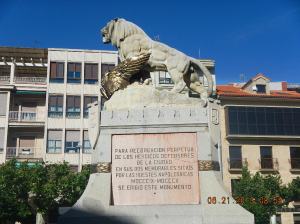
 Very, very close to the Plaza Santocildes is Astorga’s famous Chocolate Museum (Museo de Chocolate). Alas the museum had closed and I missed it but that doesn’t mean you should miss it. At times I felt like the whole town is one large chocolate factory and believe it or not I had plenty of chocolate in my backpack after my stay in Astorga.
Very, very close to the Plaza Santocildes is Astorga’s famous Chocolate Museum (Museo de Chocolate). Alas the museum had closed and I missed it but that doesn’t mean you should miss it. At times I felt like the whole town is one large chocolate factory and believe it or not I had plenty of chocolate in my backpack after my stay in Astorga.
Link to the Museo de Chocolate

Antoni Gaudí’s Gothic masterpiece El Palacio Episcopal (The Bishop’s Palace) with the Catedral de Santa Maria in the background.
My stopping point on this walk was to be the Plaza Catedral where my hotel was located and where also I had the added pleasure of seeing Antoni Gaudí’s Gothic masterpiece El Palacio Episcopal (The Bishop’s Palace). One of only three buildings designed by Gaudí outside of Barcelona, this neo-Gothic palace was designed in 1889 for his friend the Archbishop Juan Bautista Grau Vallepinós. It took twenty years to complete due to various problems including the death of the Archbishop. Today it is open for tours (alas I could not due to time constraints) and it houses the Museum of the Pilgrimage.
Link to the life story of Antoni Gaudí – A MUST READ!
The construction of La Catedral de Santa Maria was begun in 1471 over the remains of an earlier Romanesque church that was at the site from 1069 to the 13th century. The church was re-built after the 1755 Lisbon earthquake and after the French occupation (1810-1812). It is said that the cathedral’s west facade (1704) and the main retablo – one of the best Renaissance pieces on the Pilgrimage Road, designed by Gaspar Becerra (1558-62), a disciple of Michelangelo and Raphael, – are not to be missed. I did have the good fortune to view and enter this beautiful cathedral the following day as I began my walk up into the mountains of León.
Next time I will devote TWO FULL DAYS to Astorga!!!



